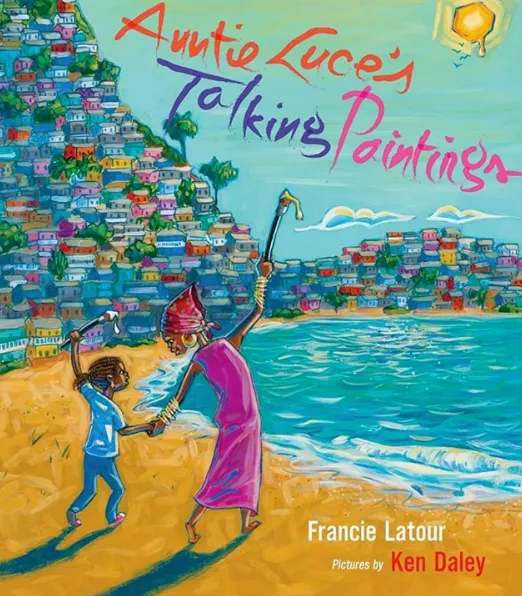Writer and journalist Francie Latour took her Haitian-American heritage, the legacy of one of Haiti’s most well-known women of the arts to create Auntie Luce’s Talking Paintings, a stunning children’s book about the US-born daughter of Haitians who discovers Haiti through her independent, and tradition-shunning aunt.

Kreyolicious: Luce Turnier, one of Haiti’s famed women painters plays a huge part in this book. At the time did you know how phenomenal it was that you were meeting her?
Francie Latour: Yes, Luce Turnier was a huge, huge inspiration for this book. I met Luce when I was 21 and living in Paris.
My mother, who was visiting me, and I were invited to meet Luce by a good friend of my mother’s, the late Mimi Barthélémy — the storyteller, actress, and amazing Haitian artist in her own right. Luce was living in a suburb just outside of Paris.
We met her, and then I went back a second time on my own. It was when I went back that she painted my portrait. This was about two years before her death.
I knew that I was meeting one of Haiti’s greatest artists, and I was awestruck by her: the way she walked, her voice, her hands, the objects she had on her shelves.
Everything. At the same time, growing up I had lived an extremely sheltered life. Like a good Haitian daughter, I followed all the rules and I tried hard to please others. So I had no real understanding of what it meant for Luce to be who she was, as a woman, as a Haitian woman, as a Haitian woman painter.
I didn’t understand all the courageous choices she had to make, at many different points in her life, to live as authentically as she did.
In the end, the character Auntie Luce ended up being kind of an combination of lots of Haitian women I’ve known — aunts, great-aunts, friends of my mother, etc — as well as Luce Turnier herself.
Kreyolicious: I thought the Caribbean background of the illustrator Ken Daley was very interesting. How did the collaboration originate?
Francie Latour: Ken was brought into the project by the publisher, Groundwood Books. Groundwood is based in Canada; Ken is also Canadian and his family is from Dominica. He is truly an AMAZING artist.
It’s a unique kind of challenge as a painter and illustrator to illustrate a book about painting, where the colors themselves are a big part of telling the story. I was and am so grateful for the chance to collaborate with him.
I had initially asked as a condition of the contract that the illustrator be a person of color, ideally with a Caribbean background. So I was excited when Ken came on board, and my natural instinct was to connect with him so we could dive into this together.
What I didn’t know is that, with children’s books, publishers work with authors and illustrators separately, and keep them separated through the process. As a first-time author, that felt strange. The story was so personal to me and so I felt like I was putting my life in a stranger’s hands.
But as soon as I started to see the sketches come in, I was bowled over. They were just so great. And then seeing them in color – amazing.
Kreyolicious: I thought the story and overall execution of the book was so well-done. Now, I’m staring at the final product. What was the process like?
Francie Latour: From what I can tell — and I say this as a novice to the children’s book world — this was kind of an unusual process. In January 2010, I had written an essay following the earthquake for the Boston Globe, where I worked for a number of years.
It was written in the form of short diary entries; it was fragmented and reflected a lot about the very common immigrant experience of feeling “in-between.”
A children’s book agent read the essay and asked to meet with me. He asked me if I would try writing a children’s book. As a parent, I was a really intentional consumer and reader of children’s books, as my kids were young at the time.
But I didn’t actually think I was capable of writing a children’s book, or any kind of fiction. As a journalist trained to write about what has already happened in reality, it was hard to think about creating something purely fictional.
I think that’s a big reason why so much of this book draws on things that happened to me in real life. And even then it was such a challenge! But interestingly, like the original story in the Globe, the book incorporates fragments of memory and feelings of cultural pride but also outsider-ness that are a big part of who I am.
I didn’t think the book would get sold, and it took a number of years for the book to actually get picked up by a publisher. So I feel extremely lucky. All of this is really unexpected.
Last Updated on November 10, 2023 by kreyolicious


